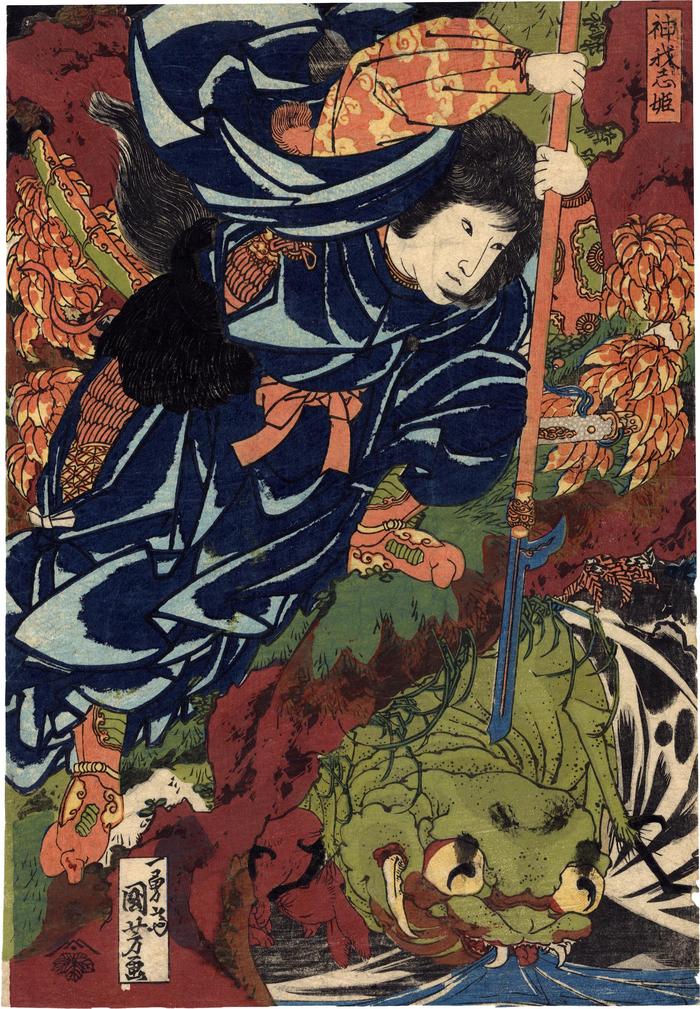Utagawa Kuniyoshi (歌川国芳) (artist 11/15/1797 – 03/05/1861)
Kamigashi-hime (神我志姫) transformed brigands into spiders then destroyed them
1824 – 1825
10.25 in x 14.5 in (Overall dimensions) color woodblock print
Signed: Ichiyūsai Kuniyoshi ga
一勇斎国芳画
Publisher: Tsutaya Kichizō (Marks 556 - 03-004)
Museum of Fine Arts, Boston
Royal Museums of Art and History, Belgium (via Cultural Japan) Henri Joly wrote in Legend in Japanese Art: A Description of Historical Episodes, Legendary Characters, Folk-lore, Myths, Religious Symbolism, Illustrated in the Arts of Old Japan, Volume 2, 1908, #411, page 156: "KAMI GASHI HIME [Joly used four completely different characters here. Here are the two *夏*媛 we think he used. We have yet to figure out the other two. Our online source is unreadable.] was a woman of the time of KEIKO Tenno who killed a huge spider in Sumo. It is generally agreed that she killed many, but that these spiders, seven feet long, were robbers in ordinary human shape, whose natures had been altered to suit the general love of legend." [That is, as we understand it, was because she was a sorceress who could transform one kind of creature into another.]
****
Kamigashi-hime, a magician heroine during the reign of the Emperor Keiko (A.D. 71-130), who while being attacked by brigands, transformed them into monstrous spiders and then destroyed them.
Basil Robinson wrote: "Kamigashi-hime thrusting her spear down on an earth-spider, which has emerged from its hole below her to drink from a stream."
From the collection of B.W. Robinson.
Use the zooming tool to enlarge this print so you can see the dead rabbit just to the left of the giant spider.
****
There are a number of difference between this print and the one in the collection of the Museum of Fine Arts in Boston. (See the link above.) First off, they were published by two different houses. The one in Boston by Sanoya Kihei and this one by Tsutaya Kichizō. Both publisher seals were used over almost exactly the same time frame, i.e., the 1820s to the 1860s. Originally our guess was that the print in Boston is the earlier one. However, on a closer look we believe that this print in the Lyon Collection is the earlier edition.
The second difference lies in the printing of both examples. Both publishers were slipshod in their use of registrations, lining up the blocks precisely. While a comparison of the area of the head of the giant spider in the Boston museum with the same area in the Lyon Collection sheet is different that does not help us determine which is the earlier printing. Note that the one in the Lyon Collection appears to have superfluous black ink marks on the tops of and above the creatures eyes. But the best way to judge these two versions is in the printing of the title and cartouche in the upper right of the print and the signature cartouche in the lower left. In the print in the Lyon Collection both of these areas are much more carefully printed.
****
Illustrated:
1) in color in Ukiyo-e from The Museum of Fine Arts, Springfield, MA, 1994, #44, page 103.
2) in color in Utagawa Kuniyoshi: 342 Color Paintings [sic] of Utagawa Kuniyoshi by Jacek Michalak, Kindle Edition, 2022, unpaginated.
warrior prints (musha-e - 武者絵) (genre)
Tsutaya Kichizō (蔦屋吉蔵) (publisher)
magicians (mahōtsukai - 魔法使い) (genre)
Yūrei-zu (幽霊図 - ghosts demons monsters and spirits) (genre)
